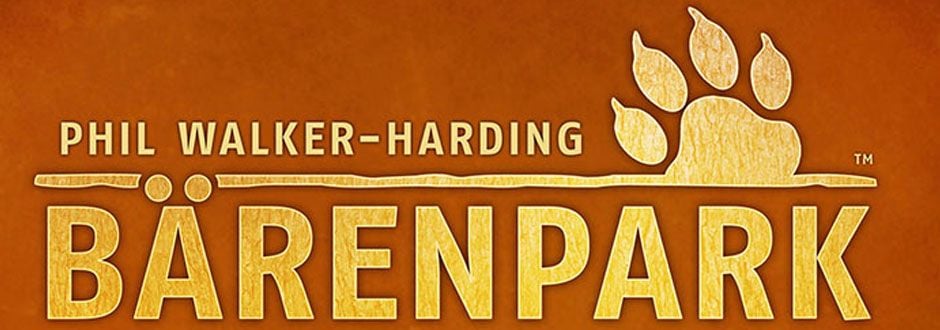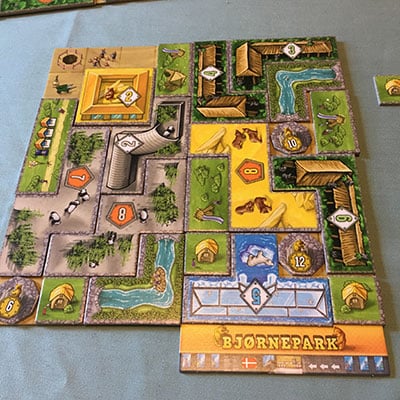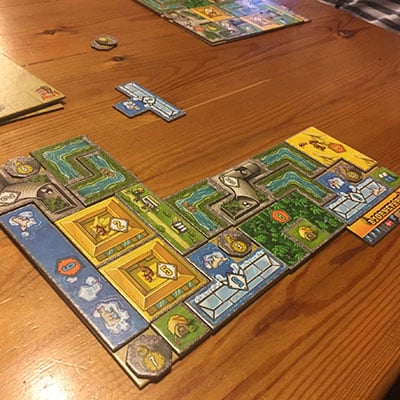Related Products
Description
Translated from German, Phil Walker-Harding’s Bärenpark means ‘bear park’. Here, up to four players compete to see who can create the best zoo, which is dedicated to housing different subspecies of bear.
Bärenpark is a gratifying tile-drafting/tile-laying, set collection game by Lookout Spiele. Players start with a single 4x4 grid, the entrance to their park, all of which have different layouts. There are various icons on some of the squares, ranging from ‘level one’ wheelbarrows, to ‘level two’ cement mixers, to ‘level three’ diggers, as well as construction workers and barricaded pits.
On your turn, you place a polyomino tile into your park, adjacent to a previously placed tile, taking note of which icons you have covered up. For every icon covered, you get to take a bear enclosure tile of corresponding victory points value (as well as varying size and shape). Some larger tiles are unique in shape, while others decrease in value, so there is a first-come-first-served nature at play.
However, the puzzle is that you cannot place any tiles in a way that covers up a pit. Instead, once the other 15 squares have been filled, this pit gains a golden bear statue, worth precious victory points. You need to get in early though, because they decrease in value the later you complete them.
The ‘level one’ wheelbarrow tiles earn you small tiles, such as a 1x1 public restroom, a 2x1 kids’ play park, a 3x1 pathway or an L-shaped river. None of these are worth any points, but wow, do they help you out when you’re left with an awkward, specific-shaped hole to fill!
Covered up the construction workers? That means you can extend your park by adding a second 4x4 grid section adjacent to your bear park. The player to first successfully fill up four sections will trigger the end of the game – but the winner will be the person that has scored the most points.
Bärenpark has quite the racing element to it. There are also mini-quests worth points upon completion to the first player to achieve them. One mini-quest, for example, requires you to place a certain number of polar bear enclosures within your park.
There are a lot of lovely things going on in Bärenpark. The artwork by Klemens Franz (of Agricola, Le Havre, and Isle of Skye fame, among many others) is cheerful and pleasant. It’s really quite simple to teach and it has the bonus of leaving you marvelling at the individual zoo you’ve created, sitting there in front of you. Bärenpark has the kind of, “Look at the pretty thing I’ve made!” factor, where you’re half-reluctant to take it apart afterwards, and put it back in the box.
When you consider the other hugely popular, family-friendly games that Phil Walker-Harding has designed – the likes of Sushi Go!, Cacao, Imhotep, and more recently, Gizmos – it’s no wonder that Bärenpark is such a roaring success.
Player Count: 2-4
Time: 30-45 Minutes
Age: 8+

I’m not much into feng shui but there is something highly satisfying about making things fit. Whether it’s the perverse relief of deleting that final phrase that takes you under the word limit on your latest essay, or finding that your new board game fits that space on your shelf perfectly, we all know the satisfaction of those moments.
In his popular game Patchwork, Uwe Rosenburg captured that feeling, tasking players with arranging tetromino style shapes to create a perfect duvet. In Cottage Garden and A Feast for Odin, Rosenburg used the system in slightly different ways again also catering for a heavier crowd with the latter.
Barenpark is firmly at the lighter end of this spectrum, offering the immediacy of Patchwork with up to four players. Each player will attempt to construct the most pleasing bear park, which we all know means the one with the least holes.
Unlike the Patchwork’s goal to create the most nearly perfect duvet, Barenpark enables you to easily construct perfectly filled in areas. The challenge here is to be the most efficient at doing so…
Building Your Dream Barenpark
Barenpark’s box is choc full of cardboard and one of the poorest thought-out inserts you are ever likely to have seen. Once you have thrown the insert away you will find Barenpark’s board has places clearly labeled for all its various shaped pieces (although one is wrongly labeled in this version – follow the rule book!). You lay out the boring but essential amenities, the standard and special bear enclosures and give each player a starting park.
What’s really interesting is the way you acquire new pieces for your park. Each player starts with an amenity piece, which are useful for filling holes but don’t score any points. They will lay this piece on their starting park in a way that covers at least one of the things pictured on it. These pictures relate to what tiles you will be able to take into your hand to place on future goes – amenities, standard or special enclosures or park expansions.




Each empty park tile also includes a hole that cannot be covered until the rest of the tile is full, at that point a player takes one of the bear statues and fills that hole. Bear statues, like the standard enclosures, are in a pile of decreasing value, meaning it’s important to be speedy as well as efficient.
I’d also recommend including the ‘advanced’ achievements as soon as possible. Choose three of them to include in each game to give more point scoring opportunities and possibly make those amenities actually worth some points. Once a player has fully covered their four park areas the game ends and scores are totaled.
Barenlark…
Barenpark is undoubtedly fun. The game starts off fairly breezy with players slowly building up and out their parks, but as the tiles become shorter in supply, and the spaces you need to fill more awkward, something changes. What at first was a fairly solitary affair, suddenly becomes a bit more cutthroat. I mean I don’t need that last scoring tile, but I can see it would fit your park perfectly so maybe i’ll just take it. In game where scores are fairly tight normally making someone have to pass a turn can be an effective strategy.
There is not much downtime as you are placing tiles from your hand so you are usually ready for your go. The only thing that might change is the tile you wanted being no longer available. This means games are usually brisk affairs with set up and tear down being noticeably more complex than the game itself…
Or Barensnark?
Because Barenpark is a light and simple game. for all the charm of its art, the theme is not really there. You are essentially racing each other to complete a puzzle. Outside of the achievements, there are no concerns for how your park stands up as an actual attraction.
There are no rules about the required amount of toilets or cafes. No clever decisions about not placing certain bears to close to each other. And for most people that’s fine, but for some the thin veneer of theme will be leave their stomach growling for more meaningful fare.
And yet I have had loads of fun with Barenpark. Despite the lightweight theme, I loved creating my own parks and loosely applying my own rules for rivers and toilets! It’s been easy to teach and enjoyable to play. I don’t think it quite replaces Patchwork in my collection but it happily sits alongside it.

Barenpark is a charming game for 2-4 players, designed by Phil Walker-Harding (of Imhotep and Archaeology fame), where you are competing to build the ultimate bear park. Your aim is to score the most points by placing bear enclosure tiles, amenities and even bear statues to maximise your score.
Barenpark Set-up
To begin the game, place the supply board in the middle of the table and place the enclosures, together with the amenity tiles (toilets, playgrounds and food streets) and river tiles on the designated spaces. Then, lay out the bear statues next to the supply board in numerical order and shuffle the 12 park areas without an entrance and place them in two piles of six.
Finally, each player selects a park area with an entrance and places it in front of them before receiving an amenity card (the lower down in turn order, the better the tile.
Gameplay
In Barenpark, play goes around the table in clockwise order and each turn consists of three steps:
Place a Tile
Place exactly one tile from your supply, ensuring that the tile fits the marked spaces in your park and that the tile is orthogonally adjacent (not diagonal) to another previously placed tile; you can rotate and flip the tile as you wish.
Evaluate Icons
Next, evaluate the icons you have covered. If you cover more than one icon, carry them all out in any order. Most icons provide new tiles and there is no limit to the number of tiles that you have in your supply;
Green Wheelbarrow – Take an amenity (green tiles) or river tile from the supply board and place in your supply.
White Cement Truck – Take the top animal house from a pile of your choice on the supply board and place it in your supply. Alternatively, you may take an amenity or river tile of your choice. The white symbols on animal houses indicate how many points you get from them.
Orange Excavator – Take an enclosure from the supply board and place it in your supply. Alternatively, you may take an amenity or river tile of your choice. The orange symbols on animal houses indicate how many points you get from them.
Construction Crew – Take the top park area from one of the two piles, then add the new park area to yours according to the following rules:
- Place the new park area orthogonally adjacent to another park area in your park.
- The bottom of the park area must be pointing towards you.
- You can’t place the park area below the entrance (It may not be closer to you than the entrance).

Barenpark Game Components (Credit: Lookout Games)
Place a Bear Statue
Finally, check whether you have completed a park area, i.e. if you have covered all the spaces (except the pit) with tiles. If you did, take the bear statue tile with the highest value from the supply and place it on the pit of the park area you’ve just completed.
Passing
When it’s your turn and you don’t have any tiles in your supply, you must pass. Take a free amenity or river tile from the supply.
Game Ending and Scoring
When a player completes all of their four park areas, each other player gets one more turn. After that, the game ends and you score your parks. To do so, add up all the tiles in your park (including bear statues). The player with the most points wins. In case of a tie, the tied players total the point values left in their supply to find the winner.
Expert Variants: Achievements
During set-up, choose three of the 10 achievements. These include such goals as including three polar bear tiles in your park or having three connected river tiles, for example. Achieving these goals will earn additional points and adds an extra level of strategy to the game.
I hope you find this Barenpark guide useful and that you enjoy playing this delightful game!

Build your own little bear-zoo with Barenpark by Phil Walker-Harding and Lookout games. Have fun strategically placing tiles, trying to snatch the higher scoring ones.
How To Play
First set up the game board by (patiently) placing all the tiles that are divided in animal houses, enclosures (higher scoring tiles) and green areas (playground, food streets, rivers and toilets).
After, choose a park area (player board) and place the spare ones next to the game board as well as the bear statues (also worth points).
The first player starts by placing a toilet, according to what they cover they will get to pick another tile. Let’s get through the icons:
– If you cover a cement mixer you can pick an animal house of your choice
– If you cover a wheelbarrow, you can pick a green area of your choice
– If you cover the construction crew, you take another park area
– If you cover an excavator/digger you can pick a bear enclosure of your choice
Remember! Never cover the pit as that is the space for your bear statue once you completed the park area.
The second player starts by placing a playground and picking new tiles, or not, according to what icon they do or don’t cover.
To cover the park area, you must place tiles down and pick up others once you cover an icon. Newly placed tiles must always touch another tile previously placed and if you do not cover any icon you don’t pick at the end of your go, you must wait for your next go to only pick up a green area without being able to place it (if your supply is empty).
The game ends when one of the players covers 4 park areas entirely. The other players get to finish the round.
Scoring is pretty easy as you add up the numbers on the tiles in your zoo.

What do we think
We picked up this game in a shop far away from home, we knew nothing about it and just asked to the sale assistant for advice since there were too many board games to choose from and according to our one-year-old we spent way too long to look at them.
The game is quite enjoyable as it is very easy to pick up and teach to people that have never played it before. It can get extremely competitive but doesn’t always leave room for strategy.
For example, Scott loves it because he just goes with the flow, doesn’t think of a strategy, only looks at filling the tiles but somehow always ends up with the high scoring tiles.
He doesn’t even look at other players park areas, just sees a tile that fits (sometimes without even noticing the score) and snatches it!
Whilst Roberta, who always thinks 3 steps ahead and loves a strategy, never seems to get to pick the high scoring tiles in time! She always tries to cover the cement mixers to get the bear houses and the diggers for the bears enclosures and then maybe if by covering that icon she could… NO!!! Strategies this time never work!
And this, my friends, is why she despises the game! If you can’t get some high scores at the beginning, you will always end up chasing your opponent and still being short a few points, there is very little chance to pick up once you fall behind.
On the other hand, Scott strolls along it all with no worry, ease and feeling relaxed, as once you get in the lead and keep playing safe, more often than not you will come out victorious.
The game caused a couple of arguments because Roberta would strop about it being unfair and not enjoyable.
The artwork is quite cute, with all those different species of bears scuttling around.
Gobbi bears have a yellow rocky desert, contrasting nicely with koalas (even if they are not bears) and their nice green leafy trees.
Polar bears have water filled enclosures that are blue and specked with ice and finally pandas have a grey background filled small bamboo forests.
We loved that the game board had a kiddy project look about it, with cute doodles a pencil and rubber printed on it, but man, setting it up takes a long time! If playing with 4 people there is 108 pieces to set out before you can start playing.
The box is very underwhelming as there are 3 bits of cardboard that fit diagonally, and supposedly divide the pieces, although we are still confused on how to do this neatly, as the plastic bags get a bit puffy.
So, our opinions here are contrasting for once, Scott wants to keep the game and would like to play it more often, Roberta wants to sell it at the next Handycon and never see it again!
Let us know what you think!
Until next time
Zatu Score
You might like
- Light and easy to teach.
- Fast playing with little down time.
- What theme there is can create fun for imaginative players.
Might not like
- Theme barely (bearly?) there.
- Too light for some.
- Set-up and tear down time.












